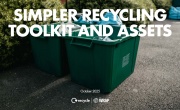An eye on the markets: A challenge of note
Angus Macpherson, Managing Director of The Environment Exchange, gives an update on the market for PRNs
As it reaches its 21st birthday, the PRN has found itself in the eye of a storm. Slightly mysterious considering that in 2018 it pumped over £130 million into the packaging recycling industry but, unfortunately for the PRN, that success has raised its profile. We now have cries for simplicity from the government without a realisation that it is not the PRN that is complex but rather the underlying process, which has so many moving parts.
A flurry of four consultations on resources and waste have followed, some focused – such as a recycled content tax for plastic, the introduction of a deposit return scheme (DRS) for drinks containers, and introducing consistent recycling collections for households – and one diffuse, exploring a range of options to not only improve the recycling of packaging but also the funding of local authorities to cover full ‘net’ costs of dealing with waste packaging, such as litter collection. The result has been broad support for the focused consultations and a myriad of answers for the unfocused one!

Meanwhile, the PRN continues to achieve its targets by placing a cost on producers for using packaging and rewarding its collection and processing. No easy task for a trading nation that is reliant on the global secondary raw material market to process over 50 per cent of its secondary raw materials, a global market that has seen restrictions imposed by China, followed swiftly by Malaysia, Thailand and Indonesia, trade wars, tariffs and fluctuating currencies, container availability and shipping rates. It’s a market, nevertheless, that is becoming increasingly reliant on secondary raw materials to survive, so as the Far Eastern markets slow down so markets closer to home, such as Turkey, open up.
PRNs can be issued on six specific types of recycled packaging material: aluminium, glass, paper, plastic, steel and wood. Each are set material specific targets: for example, the glass target is sub- divided with a minimum of 67 per cent sourced from closed loop remelting back into bottles. Once those targets are reached then there is a general recycling obligation to be met and a recovery one, which includes energy generated from used packaging.
 This article was taken from Issue 97
This article was taken from Issue 97So after an expensive year in 2018, how is 2019 shaping up? With a total obligation somewhere between 8- 8.2 million tonnes, the answer for glass, paper, steel, wood, is pretty well. On the back of strong domestic growth in glass, in uses other than re-melt, and wood, and in exports of paper, where India has stepped into the breach, and steel, prices remain higher than in previous years but are relatively steady. As a consequence of this, the general recycling and recovery targets look achievable.
The challenging areas are aluminium and plastic. Earlier in the year there was considerable outcry that data and prices were being manipulated and profiteering was taking place, but subsequent quarterly figures have revealed that genuine shortfalls exist and producers are now adjusting to the new paradigm of prices. Of equal interest is how the aluminium and plastics industries are responding to the challenge. The plastics industry, which has faced a barrage of criticism, is buckling down to the task of increasing prices to collectors, expanding UK domestic reprocessing and reducing exports. While it is still facing a significant mountain to climb to achieve its target, it is nevertheless travelling in the right direction.
In contrast, the aluminium industry, which had very successful sales last year, is dropping prices to collectors, reducing domestic reprocessing and expanding exports. While some of this can be attributed to long-running refurbishment issues at Novelis’ Warrington plant, some have been speculating that they are looking to the DRS as a public relations saviour. With a shortfall of between 5-10 per cent at the mid-year point there appears no easy short-term solution.
There are challenging times ahead. Aluminium and plastic
PRN prices will remain high in 2019 and probably beyond. At this stage, prices for all other materials look steady but who knows what unexpected hurdles Brexit might throw up!






